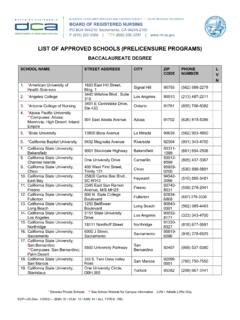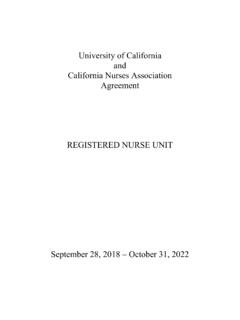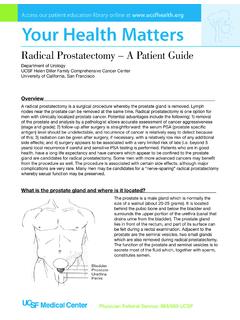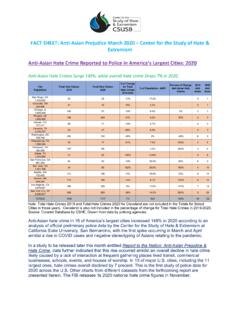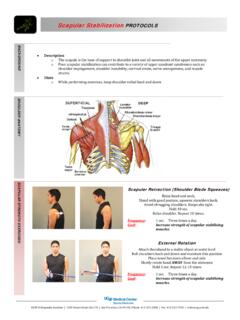Transcription of Guidelines for the Primary and Gender-Affirming Care of ...
1 Guidelines for the Primary and Gender-Affirming care of Transgender and gender Nonbinary People Center of Excellence for Transgender Health Department of Family & Community Medicine university of california , San francisco 2nd Edition Published June 17, 2016 Editor - Madeline B. Deutsch, MD, MPH Guidelines for the Primary and Gender-Affirming care of Transgender and gender Nonbinary People Introduction to the Guidelines The Center of Excellence for Transgender Health (CoE) at the university of california San francisco is proud to present these Guidelines for the Primary and Gender-Affirming care of Transgender and gender Nonbinary People. Transgender people have a gender identity that differs from the sex which they were assigned at birth, and are estimated to represent of the population.[1] Numerous needs assessments have demonstrated that transgender people encounter a range of barriers to accessing Primary health care .
2 A 2006 survey of more than 600 transgender people in california found that 30% postponed seeking medical care due to prior disrespect or discrimination, and that 10% were Primary care outright.[2] The 2011 National Transgender Discrimination Survey of more than 6000 transgender people in all 50 states found several noteworthy disparities, including 28% who delayed care due to past discrimination and 19% who were denied care outright. Most alarmingly, 50% of respondents reported having to teach their providers about their own healthcare.[3] These Guidelines aim to address these disparities by equipping Primary care providers and health systems with the tools and knowledge to meet the health care needs of their transgender and gender nonconforming patients. These Guidelines expand on the original UCSF Primary care Protocol for Transgender care , which since its launch in 2011 has served thousands of providers and policymakers across the and around the world; the page on hormone administration alone received more than 5000 visitors in the month of November, 2015.
3 These Guidelines complement the existing World Professional Association for Transgender Health Standards of care and the Endocrine Society Guidelines in that they are specifically designed for implementation in every day evidence-based Primary care , including settings with limited resources.[4,5] The overall structure and list of topics for inclusion were developed in consultation with the CoE s Medical Advisory Board (MAB), a diverse group of expert clinicians from a variety of academic and community based settings. Also contributing to the overall design and structure was a review of the range of consultation requests received by the CoE since the 2011 launch of the original Protocol. The Guidelines were then written using an authorship peer review approach. Primary authors from both within and outside the MAB were invited for individual topics, after which a peer review and modified consensus process was used to arrive at the final Guidelines presented here.
4 The diverse authorship allows the development of a broadly applicable document, rather than one that solely reflects the practice at a single academic medical center, such as UCSF. These Guidelines would not be possible without the contributions of our Medical Advisory Board and other authors and reviewers, as well as the support of my CoE colleagues JoAnne Keatley, MSW and E. Michael Reyes, MD, MPH, as well as Lissa Moran who assisted immensely with literature reviews, bibliography management, version control, copy editing, formatting, and compiling peer reviewer comments. Ben Zovod also assisted with literature reviews, bibliography management, and compiling peer reviewer comments. Their dedication and hours of hard work has resulted in a final product that is relevant, broadly applicable, evidence based, and scientifically sound. I hope you find these Guidelines useful and welcome any feedback or questions, which are June 17, 2016 2 Guidelines for the Primary and Gender-Affirming care of Transgender and gender Nonbinary People helpful in framing future revisions.
5 Thank you for caring about the health of transgender and gender nonconforming people. Madeline B. Deutsch, MD, MPH Editor Guidelines for the Primary and Gender-Affirming care of Transgender and gender Nonbinary People Director of Clinical Services Center of Excellence for Transgender Health Associate Professor of Clinical Family and Community Medicine Department of Family and Community Medicine university of california , San francisco References 1. Conron KJ, Scott G, Stowell GS, Landers SJ. Transgender Health in Massachusetts: Results From a Household Probability Sample of Adults. Am J Public Health. 2012 Jan;102(1):118 22. 2. The State of Transgender california [Internet]. Transgender Law Center. [cited 2013 Apr 1]. Available from: 3. Grant JM, Mottet LA, Tanis J, Harrison J, Herman J, Keisling M. Injustice at every turn: a report of the National Transgender Discrimination Survey [Internet].
6 National Center for Transgender Equality and National Gay and Lesbian Task Force; 2011 [cited 2016 Mar 17]. Available from: 4. Coleman E, Bockting W, Botzer M, Cohen-Kettenis P, DeCuypere G, Feldman J, et al. Standards of care for the Health of Transsexual, Transgender, and gender -Nonconforming People, Version 7. Int J Transgenderism. 2012;13(4):165 232. 5. Hembree WC, Cohen-Kettenis P, Delemarre-van de Waal HA, Gooren LJ, Meyer WJ 3rd, Spack NP, et al. Endocrine treatment of transsexual persons: an Endocrine Society clinical practice guideline. J Clin Endocrinol Metab. 2009 Sep;94(9):3132 54. June 17, 2016 3 Guidelines for the Primary and Gender-Affirming care of Transgender and gender Nonbinary People Contributors Madeline B. Deutsch, MD, MPH university of california , San francisco , Department of Family and Community Medicine Center of Excellence for Transgender Health Paula Amato, MD Oregon Health and Science university Mark Courey, MD university of california San francisco , Voice and Swallowing Center Curtis Crane, MD Brownstein & Crane Surgical Services lore m.
7 Dickey, PhD Northern Arizona university Jamison Green, PhD Jamison Green & Associates, Transgender Policy Consultants and Educators Jennifer Hastings, MD university of california San francisco , Department of Family & Community Medicine Planned Parenthood Mar Monte, Transgender Healthcare Program Katherine T. Hsiao, MD, FACOG Sutter Health, california Pacific Medical Center, Department of Obstetrics and Gynecology Dan H. Karasic, MD university of california San francisco School of Medicine, Department of Psychiatry Esther A. Kim, MD university of california San francisco , Department of Surgery, Division of Plastic and Reconstructive Surgery university of california San francisco , Department of Surgery at San francisco General Hospital Toby R. Meltzer, MD Toby R. Meltzer MD, PC Plastic and Reconstructive Surgery Juno Obedin-Maliver, MD, MPH university of california San francisco Medical Center Stanford university School of Medicine - Lesbian, Gay, Bisexual, and Transgender Medical Education Research Group Johanna Olson-Kennedy, MD Children's Hospital Los Angeles, Department of Adolescent and Young Adult Medicine June 17, 2016 4 Guidelines for the Primary and Gender-Affirming care of Transgender and gender Nonbinary People Tonia Poteat, PhD, MPH, PA-C Johns Hopkins Bloomberg School of Public Health, Department of Epidemiology, Center for Public Health and Human Rights, Center for AIDS Research Asa Radix, MD, MPH Callen Lorde Community Health Center, Research and Education Cecily Reeves, PhD, FNP-C/PA-C Samuel Merritt university , School of Nursing Stephen M.
8 Rosenthal, MD university of california San francisco , Pediatric Endrocrinology Clinics, Child and Adolescent gender Center Sarah Schneider, MS, SLP-CC university of california San francisco , Department of Otolaryngology Head and Neck Surgery university of california San francisco , Voice and Swallowing Center Nathaniel G. Sharon, MD university of New Mexico, Division of Child and Adolescent Psychiatry Eric D. Wang, MD university of california San francisco , Department of Surgery, Division of Plastic and Reconstructive Surgery Linda Wesp, MSN, NP-C university of Wisconsin-Milwaukee, College of Nursing Andre A. Wilson, MS Jamison Green & Associates, Transgender Policy Consultants and Educators Jeannine Wilson Stark, LE, CPE Transgender SF Electrolysis Barry Zevin, MD San francisco Department of Public Health, Tom Waddell Health Center June 17, 2016 5 Guidelines for the Primary and Gender-Affirming care of Transgender and gender Nonbinary People Table of Contents Introduction to the Guidelines .
9 2 Contributors .. 4 1. Grading of evidence .. 14 Table 1-1. Grading of Evidence ..14 References ..14 2. Terminology and definitions .. 15 3. Creating a safe and welcoming clinic environment .. 17 Introduction ..17 gender identity (two-step): .. 18 References ..19 4. Transgender patients and the physical examination .. 20 Introduction ..20 Special considerations for a vaginal exam in transgender women ..20 Special considerations for conducting a pelvic examination with transgender men ..21 Other special considerations ..21 References ..22 5. Overview of Gender-Affirming treatments and procedures .. 23 Supporting evidence for providing Gender-Affirming treatments and procedures ..23 References ..24 6. Initiating hormone therapy .. 25 Assessing readiness and appropriateness ..25 Qualifications of the prescribing References ..25 7. Overview of feminizing hormone therapy .. 26 Introduction.
10 26 Estrogens ..26 Antiandrogens common approaches ..27 Antiandrogens other approaches ..27 Table 7-1. Hormone preparations and dosing (Grading: T O M) ..29 Table 7-2. Laboratory monitoring for feminizing hormone therapy ..30 Overview of titration and monitoring ..31 June 17, 2016 6 Guidelines for the Primary and Gender-Affirming care of Transgender and gender Nonbinary People Monitoring estradiol levels .. 32 Monitoring testosterone levels ..33 Monitoring gonadotropin levels ..33 Monitoring hormone levels in patients using injected estrogen ..33 Interpreting sex-specific, non-hormone labs ..34 Table 7-3. Lower and upper limits of normal to use when interpreting selected lab tests in transgender women using feminizing hormone therapy ..34 Individualized dosing based on patient centered goals ..34 Specific considerations and conditions ..35 Tobacco use: ..35 Figure 7-1. Approach to management of estrogen in patients with a personal history of VTE 38 Figure 7-2.
